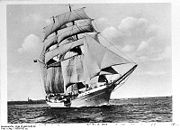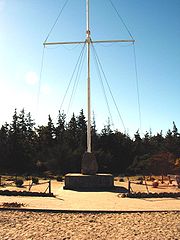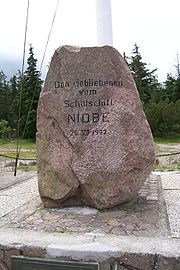
Segelschulschiff Niobe
Encyclopedia

Tall ship
A tall ship is a large, traditionally-rigged sailing vessel. Popular modern tall ship rigs include topsail schooners, brigantines, brigs and barques. "Tall Ship" can also be defined more specifically by an organization, such as for a race or festival....
used by the German Navy
German Navy
The German Navy is the navy of Germany and is part of the unified Bundeswehr .The German Navy traces its roots back to the Imperial Fleet of the revolutionary era of 1848 – 52 and more directly to the Prussian Navy, which later evolved into the Northern German Federal Navy...
to train cadets and aspiring NCOs. She sank during a sudden squall on 26 July 1932. At Gammendorfer Strand on Fehmarn island, within view of the site of the sinking, the Niobe-Denkmal monument was erected.
Construction

Schooner
A schooner is a type of sailing vessel characterized by the use of fore-and-aft sails on two or more masts with the forward mast being no taller than the rear masts....
in 1913 by the Danish
Danes
Danish people or Danes are the nation and ethnic group that is native to Denmark, and who speak Danish.The first mention of Danes within the Danish territory is on the Jelling Rune Stone which mentions how Harald Bluetooth converted the Danes to Christianity in the 10th century...
shipyard Frederikshavns Værft og Flydedok (Frederikshavner Werft und Schwimmdock) under her original name Morten Jensen and initially sailed as a freighter for F. L. Knakkegaard in Nykøbing
Nykøbing
Nykøbing means new city. It may refer to several towns:* Nykøbing Falster, on the island of Falster, Denmark* Nykøbing Mors, on the island of Mors, Denmark* Nykøbing Sjælland, on the island of Sjælland, Denmark* Nyköping Municipality and town in Sweden...
. In 1916 she was sold to Norway and renamed Tyholm.
Later that year, while carrying mine timber to England, she was captured by a German Kaiserliche Marine
Kaiserliche Marine
The Imperial German Navy was the German Navy created at the time of the formation of the German Empire. It existed between 1871 and 1919, growing out of the small Prussian Navy and Norddeutsche Bundesmarine, which primarily had the mission of coastal defense. Kaiser Wilhelm II greatly expanded...
submarine
Submarine
A submarine is a watercraft capable of independent operation below the surface of the water. It differs from a submersible, which has more limited underwater capability...
and sold to private German owners. Following several intermediate phases under various names (Aldebaran, Niobe, and Schwalbe), including one as a charter ship
Yacht charter
Yacht chartering is the practice of renting, or chartering, a sailboat or motor yacht and travelling to various coastal or island destinations. This is usually a vacation activity, but it also can be a corporate event....
for a film company, she was purchased in 1922 by the German navy which selected her name Niobe
Niobe
Niobe was a daughter of Tantalus and of either Dione, the most frequently cited, or of Eurythemista or Euryanassa, and she was the sister of Pelops and Broteas, all of whom figure in Greek mythology....
after the mythological
Mythology
The term mythology can refer either to the study of myths, or to a body or collection of myths. As examples, comparative mythology is the study of connections between myths from different cultures, whereas Greek mythology is the body of myths from ancient Greece...
daughter of Tantalus
Tantalus
Tantalus was the ruler of an ancient western Anatolian city called either after his name, as "Tantalís", "the city of Tantalus", or as "Sipylus", in reference to Mount Sipylus, at the foot of which his city was located and whose ruins were reported to be still visible in the beginning of the...
, and converted her into a three-mast barque to train future officers and non-commissioned officers. The previous training vessels, Grossherzog Friedrich August and Prinzess Eitel Friedrich, had been seized by the Allies
Allies of World War I
The Entente Powers were the countries at war with the Central Powers during World War I. The members of the Triple Entente were the United Kingdom, France, and the Russian Empire; Italy entered the war on their side in 1915...
as war reparations.

Squall
A squall is a sudden, sharp increase in wind speed which is usually associated with active weather, such as rain showers, thunderstorms, or heavy snow. Squalls refer to an increase in the sustained winds over a short time interval, as there may be higher gusts during a squall event...
on 26 July 1932, the ship capsized near the German island of Fehmarn
Fehmarn
Fehmarn is an island and - since 2003 - a town on this island in the Baltic Sea, off the eastern coast of Schleswig-Holstein, Germany, and ca. 18 kilometers south of the Danish island of Lolland...
in the Baltic Sea
Baltic Sea
The Baltic Sea is a brackish mediterranean sea located in Northern Europe, from 53°N to 66°N latitude and from 20°E to 26°E longitude. It is bounded by the Scandinavian Peninsula, the mainland of Europe, and the Danish islands. It drains into the Kattegat by way of the Øresund, the Great Belt and...
(Pos.: 54° 35,7´ N; 11° 11,2’ O) and sank within minutes as due to the hot weather, all hatches and portholes were open. 40 of her crew were rescued by the cargo ship Theresia L M Russ, but 69 died. The ship was raised on 21 August 1932, towed to Kiel and inspected while the bodies were buried. On 18 September 1933 the wreck was ceremonially sunk by a torpedo boat
Torpedo boat
A torpedo boat is a relatively small and fast naval vessel designed to carry torpedoes into battle. The first designs rammed enemy ships with explosive spar torpedoes, and later designs launched self-propelled Whitehead torpedoes. They were created to counter battleships and other large, slow and...
, attended by much of the then-small German navy.
Design
The ship had a steel hullHull (watercraft)
A hull is the watertight body of a ship or boat. Above the hull is the superstructure and/or deckhouse, where present. The line where the hull meets the water surface is called the waterline.The structure of the hull varies depending on the vessel type...
and displaced 675 tons. After her conversion into a training ship she measured 57.8 m in overall length, 46 m without the bowsprit
Bowsprit
The bowsprit of a sailing vessel is a pole extending forward from the vessel's prow. It provides an anchor point for the forestay, allowing the fore-mast to be stepped farther forward on the hull.-Origin:...
, and 9.15 m in width. The height of the main mast was 34.8 m, and she carried 15 sails with about 960 m² of total sail area. She had an auxiliary diesel engine with 240 hp. Her crew comprised 35 plus 65-80 cadets.
Literature
- Gerhard Koop: Die deutschen Segelschulschiffe, Bernard & Graefe Verlag, Bonn 1998
- Fritz Otto Busch: Niobe. Ein deutsches Schicksal, Breitkopf & Härtel, Leipzig 1932
- Walter Bölk und Erich Landschof: Schiffe in Not. Strandungen und Seeunfälle um Fehmarn 1857-1987, Verlag Heinrich Möller Söhne, Rendsburg 1988 ISBN 3-87550-090-3

